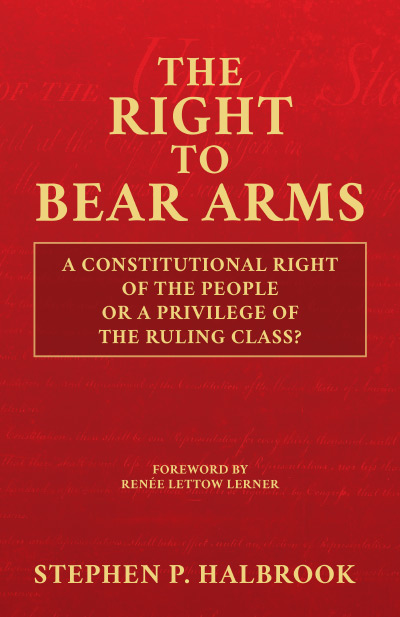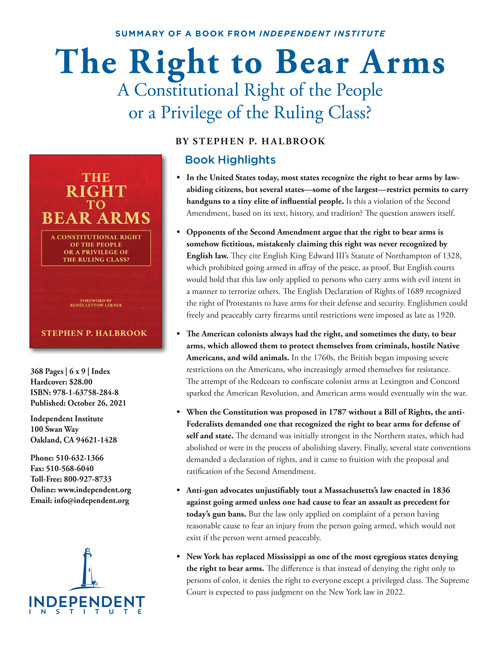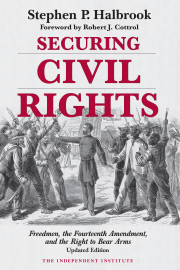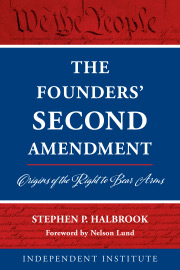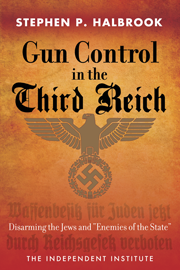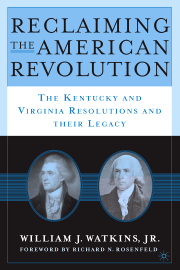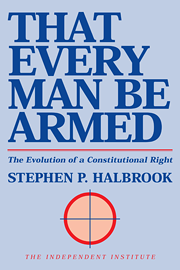| List Price: | ||
| Price: | $23.80 | |
| Discount: | $4.20 (Save 15%) |
| List Price: | ||
| Price: | $23.80 | |
| Discount: | $4.20 (Save 15%) |
Overview
Bulk discounts available. Learn more (pdf)
The Right to Bear Arms is the first scholarly study of the history of the right to bear and carry arms outside of the home, a right held dear by Americans before, during, and after the Founding period; it rebuts attempts to rewrite history and “cancel” the Founding generation’s lived experiences bearing firearms.
The U.S. Supreme Court has recognized the individual right to keep and bear arms, but courts in states having extreme gun-control restrictions apply tests that wash the right away. The book could not be more timely with the new SCOTUS case of New York State Rifle & Pistol Association Inc. v. Bruen, as this book demonstrates that the right peaceably to carry firearms is a fundamental one recognized by the text of the Second Amendment and is part of our American history and tradition.
Halbrook’s scholarly work is an exhaustive historical treatment of the fundamental, individual right to carry firearms outside of the home. He traces this right from its origins in England through American colonial times, the American Revolution, the Constitution’s ratification debates, and then through the antebellum and postbellum periods, including the history surrounding the enactment of the Fourteenth Amendment to the U.S. Constitution and up through the twentieth century to today.
The Right to Bear Arms is another important contribution by Halbrook to the scholarship concerning the text, history and tradition of the Second Amendment’s right to bear and carry arms.
Contents
1. To Go Armed 2. “That the Subjects Which Are Protestants, May Have Arms for Their Defence” 3. A Right for All SeasonsPart Two: The Fundamental Right to Bear Arms at the American Founding
4. From Colonies to Independent States 5. Adoption of the Right to Bear Arms in the Second AmendmentPart Three: The Right to Bear Arms in the Nineteenth Century
6. Going Armed in the Early American Republic 7. The Fourteenth Amendment and Its AftermathPart Four: History Marches On
8. The “Wild West,” Jim Crow, and Anti-Immigrant Aberrations to the Right to Bear Arms 9. From the State Courts to the U.S. Supreme Court 10. Today’s Limbo Game: How Low Can the Standard Go?Afterword About the Author
Detailed Summary
- In the United States today, most states recognize the right to bear arms by law-abiding citizens, but several states—some of the largest—restrict permits to carry handguns to a tiny elite of influential people. Is this a violation of the Second Amendment, based on its text, history, and tradition? The question answers itself.
- Opponents of the Second Amendment argue that the right to bear arms is somehow fictitious, mistakenly claiming this right was never recognized by English law. They cite English King Edward III’s Statute of Northampton of 1328, which prohibited going armed in affray of the peace, as proof. But English courts would hold that this law only applied to persons who carry arms with evil intent in a manner to terrorize others. The English Declaration of Rights of 1689 recognized the right of Protestants to have arms for their defense and security. Englishmen could freely and peaceably carry firearms until restrictions were imposed as late as 1920.
- The American colonists always had the right, and sometimes the duty, to bear arms, which allowed them to protect themselves from criminals, hostile Native Americans, and wild animals. In the 1760s, the British began imposing severe restrictions on the Americans, who increasingly armed themselves for resistance. The attempt of the Redcoats to confiscate colonist arms at Lexington and Concord sparked the American Revolution, and American arms would eventually win the war.
- When the Constitution was proposed in 1787 without a Bill of Rights, the anti-Federalists demanded one that recognized the right to bear arms for defense of self and state. The demand was initially strongest in the Northern states, which had abolished or were in the process of abolishing slavery. Finally, several state conventions demanded a declaration of rights, and it came to fruition with the proposal and ratification of the Second Amendment.
- Anti-gun advocates unjustifiably tout a Massachusetts’s law enacted in 1836 against going armed unless one had cause to fear an assault as precedent for today’s gun bans. But the law only applied on complaint of a person having reasonable cause to fear an injury from the person going armed, which would not exist if the person went armed peaceably.
- Mississippi passed an unconstitutional law in 1865 requiring freedmen to obtain a license to carry a firearm, subject to official discretion. That law was attacked in Congress as violative of the Second Amendment right of “the people” to bear arms. Jacob Howard proposed the Fourteenth Amendment in the Senate with the explanation that it would compel the states “to respect these great fundamental guarantees” such as the right to bear arms.
- New York has replaced Mississippi as one of the most egregious states denying the right to bear arms. The difference is that instead of denying the right only to persons of color, it denies the right to everyone except a privileged class. The Supreme Court is expected to pass judgment on the New York law in 2022.
What could be confusing about the Second Amendment’s prohibition on the infringement of “the right,” not the privilege, of “the people,” not a tiny elite, to “bear arms”? Plenty, if one muddies the water enough.
Once again, the constitutional right to bear arms is under assault. While most states issue permits to carry handguns to law-abiding persons in general or don’t even require permits, a handful of states deny the right to all but a few privileged persons. And once again, the U.S. Supreme Court will pass judgement that will affect the lives of all Americans for better or worse—the case, New York State Rifle & Pistol Association v. Bruen is the first significant gun-rights dispute to reach the bench in more than a decade. A decision is expected in 2022.
Fortunately, author and Independent Institute Senior Fellow Stephen P. Halbrook—the winner of three cases before the U.S. Supreme Court (Printz v. United States, United States v. Thompson/Center Arms Company, and Castillo v. United States)—brings clarity to this misunderstood right in his book, The Right to Bear Arms: A Constitutional Right of the People or a Privilege of the Ruling Class?
The Origin of the Right to Bear Arms
Halbrook presents a comprehensive review of the right to bear arms, tracing its development to its English origins. The Statute of Northampton of 1328, cited by some today as somehow overriding America’s Second Amendment, was actually construed as prohibiting one from going armed in a manner to terrify one’s fellow subjects. The leading precedent interpreting this medieval statute is the 1686 case of Rex v. Knight, a prosecution against a Protestant activist who carried arms for self-defense against attacks by Catholic partisans. The Catholic King James II disarmed his Protestant political opponents, prompting his removal in the Glorious Revolution of 1688. The Declaration of Rights of 1689 recognized the right of English Protestants to “have Arms for their Defence” as allowed by law.
The right to bear arms continued to be recognized in England, even in tumultuous times. What was seen as a universal right in England was reversed in oppressed Ireland. It was not until 1870 that a license to carry a gun was required in England; even then, anyone could buy the license at a post office. Only beginning in 1920 was an Englishman required to show a “need” to the authorities for a gun license, representing the loss of the right to bear arms for the English citizenry.
The American settlers would insist on, and expand, their already existing rights as Englishmen. In the colonies, carrying arms was generally an unchallenged right, a practical necessity, and sometimes a legal duty. When the Stamp Act and other oppressive measures were imposed in 1765, the Sons of Liberty protested. They often carried arms openly or concealed at will. In the 1770 homicide trials arising out of the Boston Massacre, both the prosecution and the defense agreed that individuals in the colonies had a right to carry weapons for self-defense.
While the British began to cut off the supply of arms and ammunition to the colonies, the royal administration in the colonies recognized that it had no legal power to seize arms from the colonists. But once armed conflict erupted at Lexington and Concord, British commander Thomas Gage demanded that Bostonians surrender their firearms in exchange for safe passage to leave the city. He then confiscated the firearms and reneged on his promise. The Revolution was on, and the independent states began adopting constitutions and bills of rights, including recognition of the preexisting right to bear arms.
The Trials and Tribulations of the Second Amendment
When the Constitution was proposed, the alarm went out that it had no bill of rights. Recognition of the right to bear arms was demanded along with freedom of speech. James Madison proposed what became the Second Amendment, and the Bill of Rights was ratified by the states in 1791. The right to bear arms for self-defense was taken for granted. The federal Militia Act of 1792 required able-bodied males to arm themselves. The Founders personally carried arms and defended the right to do so.
At the beginning of the early Republic, citizens were at liberty peaceably to carry arms outside the home in public, openly or concealed, without any restrictions. Legal commentators acclaimed the constitutional right to bear arms as the palladium of liberty of a free state.
By statute or judicial decisions, some states prohibited going armed in a manner that would terrorize others, and required violators to find sureties to keep the peace. In 1813, two states banned the carrying of concealed weapons; a handful of other states followed. Courts upheld these restrictions because one could bear arms openly.
The slave codes provided the dishonorable exception to the right to bear arms, as well as to other rights. Slaves were virtually prohibited from firearms possession, while free blacks were required to obtain a license to carry a firearm. Like today, in America’s “may issue” carry states, licenses were subject to the discretion of the government’s issuing authority.
When slavery was abolished, the Southern states enacted the Black Codes, which required African Americans to obtain a license, subject to official discretion, to possess and carry firearms. Congress sought to prohibit the confiscation of unlicensed firearms from the newly-freed slaves through passage of the Civil Rights and Freedmen’s Bureau Acts of 1866. The Fourteenth Amendment was proposed and ratified intending, in part, to protect the right to bear arms from state violation, and the Civil Rights Act of 1871 provided for enforcement of that and other rights. The courts responded with mixed results to the carry restrictions that were enacted in a handful of states during Reconstruction.
The Supreme Court’s Impact on the Right to Bear Arms
The U.S. Supreme Court weighed in with two decisions in the last quarter of the nineteenth century. United States v. Cruikshank held that the rights to assemble peaceably and to bear arms for a lawful purpose preexisted the Constitution, but no basis existed for the federal prosecution of private individuals for violation of the exercise of those rights by African Americans. And in Presser v. Illinois, the Court held that the requirement of a license to parade with arms in cities, which was passed during a period of labor unrest, did not infringe on the right to bear arms. Both of these decisions pre-dated the Supreme Court’s adoption of the “incorporation doctrine” of the Fourteenth Amendment.
Before and after the turn of the century, restrictions were sporadically enacted against the bearing of arms in unique contexts not shared by most of America. Far from being predominant or longstanding, these laws were needles in a haystack. Some “Wild West” cattle towns disallowed the carrying of firearms, although statehood and court rulings invalidated some of the bans. Jim-Crow-inspired licensing requirements and fees essentially prohibited blacks from exercising the right to bear arms in some states. And New York’s Sullivan Law of 1911, named after a politician with ties to organized crime, sought to ensure that Italians and other immigrants went to prison if they dared to carry a gun for self-defense.
In the twentieth century and beyond, the state courts upheld the right to bear arms under state constitutional guarantees. The U.S. Supreme Court upheld the common law right to be armed in self-defense, opined in dictum that restrictions on concealed carry did not violate the right to bear arms, and in United States v. Miller, held that militia arms are protected by the Second Amendment.
In District of Columbia v. Heller (2008), the Court held that the District’s handgun ban violated the individual right to keep and bear arms. The opinion clarified that to “bear arms” means to carry arms and has no exclusive militia context. And it rejected the view that the right could be dismissed by judge-made interest-balancing tests. That was followed by the Supreme Court’s McDonald v. Chicago decision in 2010, which held the right to arms to be fundamental and protected from state violation by the Fourteenth Amendment.
Since Heller and McDonald were decided, state carry bans have been litigated in the lower federal courts. Some federal circuits have found discretionary issuance laws to violate the right of the public at large to bear arms. Other circuits have upheld the denial of the right to ordinary citizens, typically under a watered-down version of intermediate scrutiny that allows judges to balance away the right.
The Future of the Right to Bear Arms
The Supreme Court granted review of New York’s discretionary-licensing law in a case called New York State Rifle and Pistol Association v. Bruen. A decision is expected in 2022. Will the Supreme Court uphold the universality of the right to bear arms as enshrined in the Second Amendment? Or will the outcome further erode this constitutional right, such that the term loses its meaning? Only time will tell.
The way and extent to which the right to bear arms is exercised may vary with societal changes, uncertainties, and disasters. The year 2020 exemplified that, with record gun sales being prompted by political transformations resulting in greater restrictions in certain states, fewer restrictions in other states, the arrival of the coronavirus and its devastating impact, and the sparking of rioting and pullback of law enforcement nationwide.
Whatever the future holds, the Second Amendment and the ongoing love affair of Americans with private firearms ownership have endured for well over two centuries. If some politicians and judges are mystified by the meaning of the words “the right of the people to...bear arms,” most Americans are not.
Praise
“In The Right to Bear Arms, Halbrook has provided a comprehensive, up-to-date review of the New York case pending before the U.S. Supreme Court, while elaborating on the historical and principled meaning of the Second Amendment. This book could not appear at a more auspicious moment. The reality is that the decision in the prior Heller and similar cases that the Second Amendment is a personal right and not a privilege afforded by governmental units is perhaps in greater danger now than it was before Heller. The evident temptations to rescind from the broadest implications of Heller have courts and judges seeking ways to water down that fundamental principle, and there is more than a little reason to fear some of that tendency emerging at the Supreme Court in the guise identifying historical developments as qualifying the plain language of the Second Amendment. Halbrook greatly diminishes the prospect of a satisfactory completion of that misguided task.” —William B. Allen, Jr., Emeritus Dean and Professor of Political Philosophy, James Madison College, Michigan State University; former Chairman, U.S. Commission on Civil Rights
“In the extraordinary and timely book, The Right to Bear Arms, Stephen Halbrook—long a leading scholar on the origin and importance of the Constitution’s Second Amendment—explains why the right to bear arms outside the home is not only fundamental to the individual’s right to self-defense, but is an indispensable foundation for popular sovereignty itself. For too long, ‘liberals’ and ‘progressives’ have denigrated the Second Amendment and fooled themselves into believing that if we could only regulate and ban guns, criminal activity could be curtailed. As we ought to have learned by now, this approach was naïve, dangerous, and counterproductive. Once again, and as the Supreme Court is poised to revisit interpretation of this most important Amendment, Halbrook’s wisdom is rare and invaluable.” —Stephen B. Presser, Raoul Berger Professor of Law Emeritus, Pritzker School of Law; Professor of Business Law Emeritus, Kellogg School of Management; Northwestern University; author, Law Professors: Three Centuries of Shaping American Law
“Stephen Halbrook is a pioneer of Second Amendment scholarship and nobody does it better. Now, in his book The Right to Bear Arms, he systematically demolishes the latest historical claim that the ‘right to...bear arms’ did not extend to carrying guns outside the home. A timely and accessible read for scholars, for lawyers, for judges, and for all ‘the people’ who value their right to arms.” —Randy E. Barnett, Patrick Hotung Professor of Constitutional Law, Georgetown University Law Center; Director, Georgetown Center for the Constitution; and author, The Original Meaning of the 14th Amendment: Its Letter and Spirit
“Stephen Halbrook’s The Right to Bear Arms is a superb examination of a topic at the very core of Second Amendment controversies—the actual carrying of arms and the central role of self-defense in the American republic. His mastery of the legal and constitutional literature in this penetrating study is formidable and conclusive, presented in a historical narrative rich in detail. It will be crucial reading for the legal community actively involved in the fight for the Second Amendment as well as to all who are students of liberty. In his long and highly productive engagement with the right to bear arms, this great scholar has explored his subject from many angles in many books. This one is a powerhouse.” —T. Hunt Tooley, Professor of History, Austin College; his books include The Great War: Western Front and Home Front, National Identity and Weimar Germany and Ethnic Cleansing in Twentieth-Century Europe
“Stephen Halbrook’s book, The Right to Bear Arms, should not have been needed. But those seeking to confine the Second Amendment right to carry a gun to the home persist in obfuscating its text, history and landmark Supreme Court opinions. Happily, the Supreme Court is finally poised to rule, once again on the issue. Halbrook’s coverage from early English law through modern cases provides a comprehensive guide for Courts and the perplexed. Those who believe the Second Amendment means what it says owe him our sincere thanks.” —Joyce Lee Malcolm, Patrick Henry Professor Emerita of Constitutional Law and the Second Amendment, Antonin Scalia School of Law, George Mason University; author, To Keep and Bear Arms: The Origins of an Anglo-American Right and Guns and Violence: The English Experience
“With his comprehensive book, The Right to Bear Arms, Stephen Halbrook gives us an important history of a right often disparaged by elites but frequently cherished by ordinary citizens—the right to bear arms for self-defense. This timely book is must reading for those concerned with the civil right of self-preservation.” —Robert J. Cottrol, Harold Paul Green Research Professor of Law and Professor of History and Sociology, George Washington University; author, The Long, Lingering Shadow: Slavery, Race, and Law in the American Hemisphere
“A disarmed population is much easier to subdue and hold in servitude than an armed one. Stephen P. Halbrook’s The Right to Bear Arms: A Constitutional Right of the People or a Privilege of the Ruling Class? unambiguously confirms this fundamental insight by addressing assaults against the Second Amendment. Thankfully, SCOTUS upheld Second Amendment rights in District of Columbia v. Heller (2008) and McDonald v. City of Chicago (2010). Should SCOTUS backtrack on those decisions, Halbrook provides two invaluable services. First, making clear that the backtracking is constitutionally illegitimate. And second, that the tree of liberty will die without nourishment from the natural right to keep and bear arms.” —Marshall DeRosa, Professor of Political Science, Florida Atlantic University
“The U.S. Supreme Court has granted certiorari to hear a major case on the right to bear arms, New York State Rifle & Pistol Association Inc. v. Corlett. By happy coincidence, the best book on the legal history of the right has just been published: Stephen P. Halbrook, The Right to Bear Arms: A Constitutional Right of the People or a Privilege of the Ruling Class? Halbrook’s book will be central to the Supreme Court case, just as Halbrook’s previous work was for the Supreme Court’s decisions in District of Columbia v. Heller and McDonald v. Chicago—not only in direct citations, but also in the many original sources that Halbrook was the first to write about, and which the Court incorporated in its opinions. Indeed, Halbrook’s scholarship was a foundation of McDonald case, for he had demonstrated in irrefutable detail that Congress passed the Fourteenth Amendment for the explicit purpose of, inter alia, protecting the right to arms of former slaves to keep and bear arms for personal and family defense. . . . Any serious person involved in the legal debate over the right to bear arms will have to address the arguments in Halbrook's latest book.” —The Volokh Conspiracy
“Stephen Halbrook’s The Right to Bear Arms is particularly timely now, when critics allege tainted origins of so many American institutions. The right to own and carry guns, as Halbrook shows, grew from a long, honorable tradition in Anglo-American law of trusting the common man to defend himself. It was, as this book shows, the attempt to deny historic gun rights that grew out of racial animus in the Jim Crow South and anti-immigrant prejudice in Northern cities.” —Jeremy A. Rabkin, Professor of Law, Antonin Scalia Law School, George Mason University; Member, Board of Directors, U.S. Institute of Peace
“Everyone, especially state legislators, should read The Right to Bear Arms, the carefully documented, exhaustive study of the right to bear and carry arms outside the home as developed in the American legal tradition.” —Donald W. Livingston, Professor Emeritus of Philosophy, Emory University; former Fellow, Institute for Advanced Studies in the Humanities, University of Edinburgh
“The Right to Bear Arms by Stephen Halbrook, is a comprehensive, incisive and timely history of the Second Amendment to the U.S. Constitution. The positioning of the Amendment, right after the First Amendment in the Bill of Rights, Halbrook suggests, signals just how important and indispensable James Madison and others considered the Amendment to be. Yet, the real controversy today, is whether the framers intended the right to bear arms for self-defense to extend outside one’s home. And Renée Lettow Lerner notes in her engaging and informative foreword to Halbrook’s excellent treatise, gun purchases soared by 65% in 2020 as urban unrest and crime dramatically climbed. Indeed, the murder rate in 57 U.S. cities increased by an average of 37% in 2020, and when 85% of murders in a major city like Detroit are not solved, is it any wonder that citizens feel the need to purchase firearms for self-defense?” —Phillip G. Henderson, Professor of Politics, Catholic University of America; author of Managing the Presidency: The Eisenhower Legacy and editor of The Presidency Then and Now
“The U.S. Supreme Court has agreed to review a case involving the right to bear arms outside one’s home, and Stephen Halbrook’s new book, The Right to Bear Arms, will give the Justices most of the historical evidence they need to decide the case correctly.” —Nelson Lund, University Professor, Antonin Scalia Law School, George Mason University
“Written by Stephen Halbrook, one of America’s most knowledgeable and experienced legal experts on gun control and the Second Amendment, The Right to Bear Arms provides a comprehensive, thoroughly documented, and highly readable historical analysis of one of the most controversial and important public-policy issues facing the nation today. It should be mandatory reading for elected officials and is highly recommended for constitutional scholars, students, and citizens who wish to understand these issues.” —Robert F. Turner, former Charles H. Stockton Professor of International Law, Naval War College; Co-Founder and Distinguished Fellow (Retired), Center for National Security Law, University of Virginia School of Law; First President, U.S. Institute of Peace; Chairman, Jefferson-Hemings Scholars Commission
“With the U.S. Supreme Court decision taking up the issue of concealed handguns, Stephen Halbrook’s The Right to Bear Arms is perfectly timed to get people up to speed on the legal arguments the court will face. If you want to be prepared for the upcoming legal debate and how Justice Antonin Scalia explained that the Constitution protects Americans' right to self-defense and carry guns, this book is the book for you.” —John R. Lott, Jr., former Senior Advisor for Research and Statistics, Office of Legal Policy and Office of Justice Programs, U.S. Department of Justice; author, More Guns, Less Crime: Understanding Crime and Gun Control Laws
"In The Right to Bear Arms, Stephen Halbrook has done it again, and just in time. As our country’s slide into oligarchy is accelerating, he has provided another definitive analysis of the importance of the Second Amendment’s right to keep and bear arms. It is not just for the militia, or for personal defense inside the home, but it extends to self-defense outside the home and, most importantly, to the defense against those who would tyrannize a free people. Bravo!" —John C. Eastman, Founding Director, Center for Constitutional Jurisprudence, Claremont Institute
“The U.S. Supreme Court will take up a high-stakes Second Amendment case that experts say has the potential to expand gun rights and radically increase the number of firearms on the streets of major cities already plagued by shootings. The nation’s highest court said . . . that it will hear an appeal on whether New York’s permit requirements for carrying guns in public is constitutional, and ultimately whether the Second Amendment protects Americans’ right to carry guns outside of their homes. . . . ‘This is the most significant Second Amendment issue that’s been before the Court,' says Stephen Halbrook, . . . author of The Right to Bear Arms: A Constitutional Right of the People or a Privilege of the Ruling Class?” —Time Magazine
“The U.S. Supreme Court has recognized the individual right to keep and bear arms, but courts in states that have extreme gun control restrictions apply tests that balance the right away. The Right to Bear Arms: A Constitutional Right of the People or a Privilege of the Ruling Class? by Stephen P. Halbrook demonstrates that the right to peaceably carry firearms is a fundamental right recognized by the text of the Second Amendment and is part of our American history and tradition. Halbrook's scholarly work is an exhaustive historical treatment of the fundamental, individual right to carry firearms outside of the home. Halbrook traces this right from its origins in England through American colonial times, the American Revolution, the Constitution's ratification debates, and then through the antebellum and post-bellum periods, including the history surrounding the enactment of the Fourteenth Amendment to the U.S. Constitution. An important and timely contribution to our on-going national discussion over gun safety measures and 2nd Amendment rights, The Right to Bear Arms: A Constitutional Right of the People or a Privilege of the Ruling Class? is an especially and unreservedly recommended addition to community, college, and university library Political Science, Constitutional Law, and Contemporary Social Issues collections. It should be noted for the personal reading lists of students, academia, political activists (on both sides of the issue of gun control), and non-specialist general readers.” —Midwest Book Review
“We live in an increasingly dangerous world. Our ability to travel safely through streets and other public places is in jeopardy, as police budgets are slashed and woke prosecutors and unprincipled politicians refuse to enforce the law against violent criminals. Bearing arms in public, to protect oneself and one’s family from those who would harm them, may soon be the most important right guaranteed by the Constitution. Yet the very same elites that have brought about this dangerous situation have, for decades, dismissed, denied and denigrated this right, and some courts have, in the words of my former colleague, Judge Diarmuid O’Scannlain, reduced the constitutional text to a ‘mere inkblot.’ As the Supreme Court is poised to take up the issue, Stephen Halbrook’s authoritative book The Right to Bear Arms, on the history of the right to bear arms, will no doubt influence the Court’s decision, as his earlier works influenced the Court’s rulings in Heller and McDonald. Meticulously tracing the history from the early English common law, through colonial times, the Founding era, the ‘Wild West’ and the shameful efforts to disarm southern Blacks during the Jim Crow era, Halbrook leaves no doubt that that the right to carry a weapon as protection against malefactors and overreaching governments is at the core of who we are as Americans. Halbrook warns us that ‘it is a universal law of history that tyrants attempt to disarm their subjects.’ This book will help ensure that it won’t happen here.” —Alex A. Kozinski, former Judge, U.S. Court of Appeals for the Ninth Circuit
“With over one-third of U.S. states having adopted constitutional carry laws, it seems apropos to point out the Second Amendment was the Founding Fathers’ carry permit. Which, by the way, is why permitless carry is called constitutional carry, as it is a return to carrying guns for self-defense based on the authority of the Bill of Rights rather than the possession of government-issued permit. . . . By adopting a constitutional carry framework, states are simply returning to the view of bearing arms held by our Founding Fathers in 1791, the year the Second Amendment was ratified. (And this is not an argument about a certain way of bearing arms; i.e., not an argument about carrying concealed versus carrying open or vice versa. It is about bearing arms for self-defense, period.) This view was well presented in the masterful book, The Right to Bear Arms: A Constitutional Right or a Privilege of the Ruling Class?, where Stephen Halbrook writes, ‘At the beginning of the early Republic, citizens were at liberty to peaceably carry arms outside the home in public, openly or concealed, without any restrictions. Legal commentators acclaimed the constitutional right to bear arms as the palladium of liberty of a free state.’” —Breitbart News
“Writing good history is about honest interpretation. . . . Which brings us to Stephen P. Halbrook and his latest book The Right to Bear Arms: A Constitutional Right of the People or a Privilege of the Ruling Class? When it comes to unearthing the real history of the Second Amendment, there is no one better than Halbrook. He knows that honest books on the Second Amendment need to go to original documents, as they focus on taking out the spin from modern academics, the mainstream media, and from some of today’s politicians. . . . His book The Right to Bear Arms is an intriguing study of the history of the right to carry arms outside of the home. As such, it rebuts attempts by anti-gun advocates to rewrite history and ‘cancel’ the Founding generation’s experiences with firearms. . . . With deep, historical analysis, this book clearly shows that the right to peaceably carry firearms is a fundamental right protected by the Second Amendment, and is part of our American history and tradition. Read this book and you’ll be able to cite the facts to anyone when the mainstream media attempts to twist this issue with dishonest narratives.” —America’s 1st Freedom
“The title of Stephen P. Halbrook’s new book, The Right to Bear Arms, is the very question at issue in the case of New York State Rifle & Pistol Association v. Corlett, which the United States Supreme Court recently decided it would hear in its next term. The timing and importance of both the book and this case couldn’t have been better! . . . Halbrook’s book serves as a literary weapon in support of our Second Amendment right by clearly identifying what the Second Amendment means and requires. . . . The Corlett case and Halbrook’s book comes to us at a time when the Bill of Rights in its entirety—all ten of them—are on trial! . . . Scholar Stephen P. Halbrook explains clearly and convincingly the importance of the right to bear arms and its practice, from its origins in England—going back as far as the early 1300’s—through colonial America, and then through ratification of our Constitution and Bill of Rights, up to the present day. His thorough analysis includes references to and explanations of important state and federal court cases. . . . Given the danger presented to the Nation due to a rampaging radical Marxist agenda, permeating society from the highest levels of the Federal Government to the local government level, and given dramatic increases in violence on our streets, the nation’s need for Stephen Halbrook’s book is pressing. The material presented directs the public’s attention back to where that attention needs to be directed: toward an understanding of and appreciation of our nation’s historical roots. The information provided in Halbrook’s book should be shared by everyone—regardless of political or ideological persuasion—all who truly value and appreciate the freedom, liberties, and rights, we enjoy in America.” —Ammoland Shooting Sports News
Awards
2021 International Book Awards (American Book Fest)
- Winner in History: United States
2022 IBPA Benjamin Franklin Awards
- Silver Winner in Political & Current Events
Amazon.com
- #1 New Release in Constitutions

